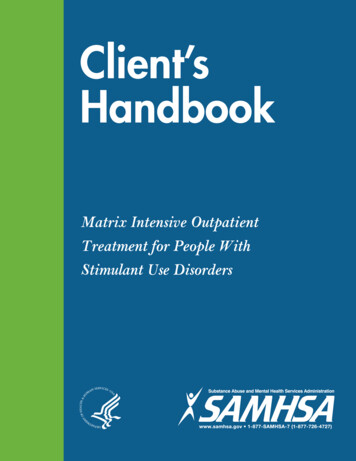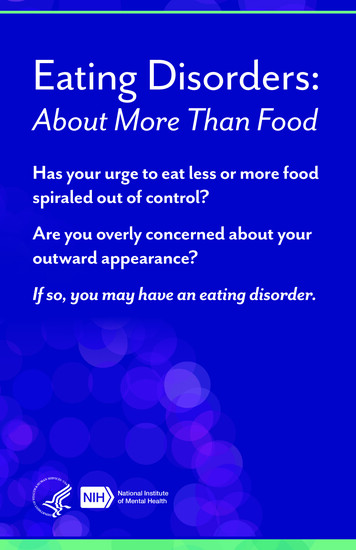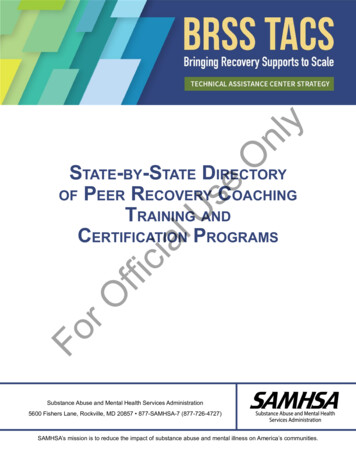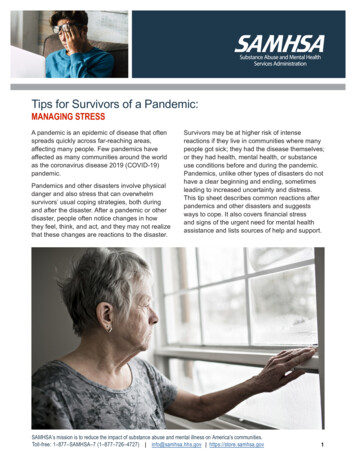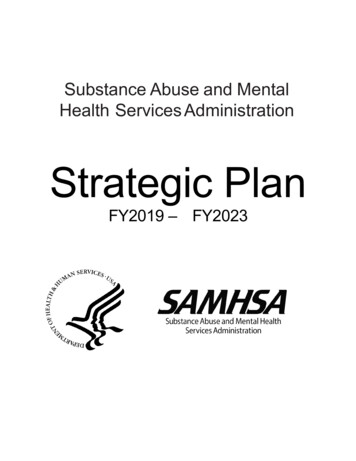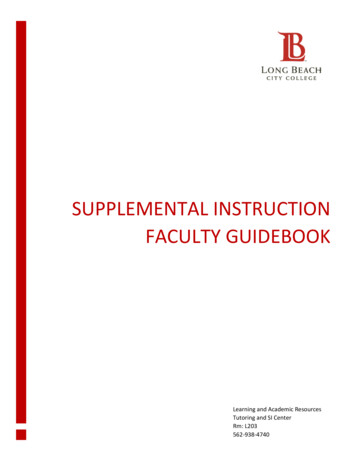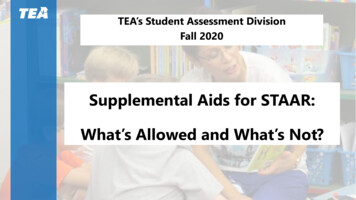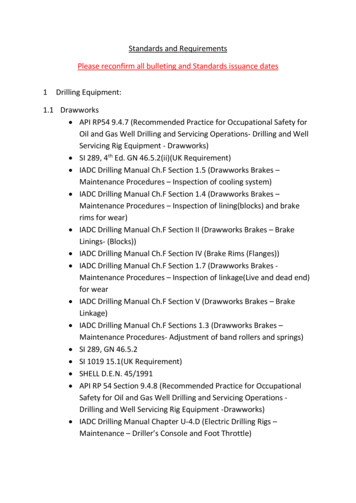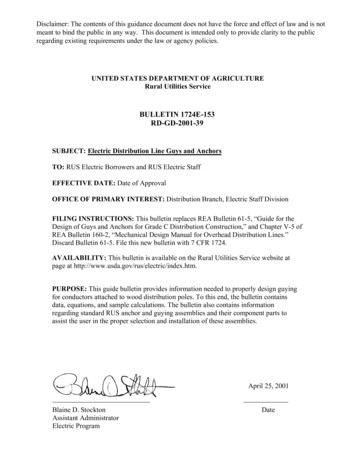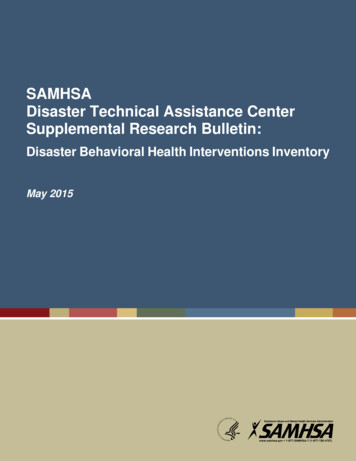
Transcription
SAMHSADisaster Technical Assistance CenterSupplemental Research Bulletin:Disaster Behavioral Health Interventions InventoryMay 2015
This Supplemental Research Bulletin is an inventory rather than a review of current research inthe field of disaster behavioral health (DBH). The inventory primarily comprises disaster-specificinterventions, although several may also be used to assist people who are suffering withdistress or disorders associated with other types of traumatic events. The interventions used tosupport survivors of other types of traumatic events are generally applicable to disastersurvivors in the later stages of response activities. Finally, a few of the interventions (those usedin the long-term recovery phase of disaster) are applicable only when the survivors have beenfully assessed by a licensed or certified professional and determined to have a diagnosabledisorder, such as major depression, posttraumatic stress disorder (PTSD), or other anxietyrelated disorders.The immediate and intermediate interventions help achieve two goals of disaster behavioralhealth: Mitigate the development of serious mental disorders. Provide tools that support the natural recovery process that occurs with time for themajority of the affected population.The majority of interventions applied in the acute/immediate and intermediate responsephases are appropriate for survivors who continue to function well but may have continuingbothersome symptoms and who have not been formally diagnosed with a mental illness.According to a recent study, the prevalence of PTSD 6 years after a disaster was 11.3 percent,and the current prevalence was 4.2 percent, with onset mainly within 1 month and remissionwithin 3 years post-disaster. i Many variables contribute to whether a person will experiencePTSD, such as their history of trauma, preexisting mental health condition, socioeconomicstatus, access to social supports, and other influences. These survivors should be provided withtreatment options as soon as their condition has been identified, or as soon as they have beenformally assessed by a mental health professional. Formal mental health treatment services areat the far end of the spectrum in terms of DBH.Most interventions are categorized by the time in which they should be administered after adisaster (early, intermediate, and long term) and can be applied to the majority of survivorswho experience the most common reactions. Interventions that are available via Internet,smartphone applications, and other electronic technology are inventoried within their owncategory. We also use checklists that identify standard aspects of each intervention, including: The modality by which they can be delivered (e.g., individual, family, group) The settings in which they can be delivered (e.g., in the field, in schools, at theworkplace) The status of their research base (with a wide spectrum from empirical evidence tounpublished) ReferencesWe hope this inventory of interventions is helpful to your work in responding to the behavioralhealth needs of disaster survivors.
Warmest regards,CAPT Erik Hierholzer, B.S.N.Program Management Officer, Emergency Mental Health and Traumatic Stress Services BranchErik.hierholzer@samhsa.hhs.govNikki Bellamy, Ph.D.Public Health Advisor, Emergency Mental Health and Traumatic Stress Services BranchNikki.bellamy@samhsa.hhs.govBrenda MannixSAMHSA DTAC Project DirectorDTAC@samhsa.hhs.goviArnberg, F.K., Johannesson, K.B., and Michel, P. (2013). Prevalence and duration of PTSD in survivors 6 years aftera natural disaster. Journal of Anxiety Disorders, 27(3), 347-352.Please note: SAMHSA does not officially endorse each intervention; rather this document presents interventionpractices commonly used in the field and reported in the science- and evidence-based research literature.
CONTENTSEARLY INTERVENTIONS .11. Assessment, Crisis Intervention, and Trauma Treatment (ACT) . 12. Cognitive Behavioral Therapy for Acute Stress Disorder (CBT for ASD) . 23. Community Emergency Response Teams (CERT) . 34. Consultation, Outreach, Debriefing, Education, and Crisis Counseling Disaster Mental HealthService Model (CODE-C DMHSM) . 45. Crisis Counseling Assistance and Training Program (CCP) . 56. Critical Incident Stress Debriefing (CISD) . 67. Early Psychological Intervention (EPI) . 78. The Families’ GOALS Project: Going on After Loss . 89. Group Crisis Intervention: Public Mental Health Service Delivery Protocols: Group Interventionsfor Disaster Preparedness and Response. 910. Healing After Trauma Skills (HATS) . 1011. National Organization for Victim Assistance (NOVA) Crisis Response Team (CRT) . 1112. Operation Solace Program Model. 1213. Psychological First Aid (PFA) . 1314. The PFA RAPID Model . 1415. Nebraska PFA . 1516. PFA for Schools . 1617. Building Workforce Resilience Through the Practice of Psychological First Aid—A Course forSupervisors and Leaders (PFA-L) . 1718. PsyStart Rapid Mental Health Triage and Incident Management System. 1819. Listen, Protect, Connect Model of PFA . 1920. Recovery Efforts After Adult and Child Trauma (REACT) . 2021. Screening, Brief Intervention, Referral to Treatment (SBIRT) . 2122. Seeking Safety . 2223. Wave Riders. 2324. Mental Health First Aid (MHFA) . 24INTERMEDIATE INTERVENTIONS . 251. Cognitive Behavioral Therapy for Post-Disaster Distress (CBT-PD) . 252. Classroom-Based Intervention (CBI) . 273. Cognitive Behavioral Intervention in Schools (CBITS) . 284. Mind/Body Therapies . 295. Skills for Psychological Recovery (SPR) . 316. Specialized Crisis Counseling Services (SCCS) . 327. Writing for Recovery . 33
LONG-TERM INTERVENTIONS .341. Cognitive Processing Therapy (CPT) . 342. Eye Movement Desensitization and Reprocessing (EMDR) . 363. Stress Inoculation Training (SIT) . 384. Prolonged Exposure Therapy . 395. Psychodynamic Psychotherapies . 406. Skill Training in Affect and Interpersonal Regulation (STAIR). 417. Systematic Desensitization . 428. Trauma-Focused Cognitive Behavioral Therapy (TF-CBT) . 439. Trauma Systems Therapy (TST) . 44INTERNET-BASED INTERVENTIONS (IBIs)/APPLICATIONS (APPS) . 461. Cognitive Processing Therapy (CPT) Coach Mobile App. 462. Disaster Distress Helpline/TalkWithUs. 483. My Disaster Recovery (web based) . 494. National Suicide Prevention Lifeline. 505. PTSD COACH . 516. Bounce Back/Bounce Back Now (technology based) . 52APP-BASED RESOURCE TOOLS FOR RESPONDERS. 531. SAMHSA Behavioral Health Disaster Response App . 532. SAMHSA Suicide Safe Mobile App . 533. Psychological First Aid (PFA) Mobile App . 53
EARLY INTERVENTIONSA National Institutes of Health study published in the International Journal of Emergency Mental Healthin 2005 examined the behavioral health of a sample of New York City residents 2 years after 9/11. Theauthors recommended that “crisis intervention services should be considered as a first line ofemergency management for those potentially affected by large-scale community disasters.”1 Earlyinterventions are typically defined as any form of psychological intervention delivered within the first 4weeks of a potentially traumatic event.2 Some early interventions are intended for implementationduring the acute phase (within hours or days of a traumatic event), whereas others are initiated 1 to 4weeks post incident.3 These interventions are meant to “lend” survivors the strengths needed todecrease their fear responses (thereby calming themselves) and access immediate care and support,allowing them to move to the next stage of recovery.1. Assessment, Crisis Intervention, and Trauma Treatment (ACT)Author: Albert R. RobertsWebsite: ef Description: ACT is a conceptual three-stage framework and intervention model that can be usefulin helping mental health professionals provide acute crisis and trauma treatment services. This modelmay be thought of as a sequential set of assessments and intervention strategies, as it integrates variousassessment and triage protocols with the seven-stage crisis intervention model and the 10-step acutetraumatic stress management protocol.Delivery Mode Individual Group Victim Family Rescue and Recovery RespondersDelivery Setting Family Assistance Centers Private Homes Classrooms Responder AgenciesResearch Base Empirically Supported Treatment (EST) Evidence-Informed or Evidence-BasedBehavioral Practice (EBBP) Family (general) Community Direct Survivors Other Responders Field/Community Schools (general) Faith-Based Settings Other Evidence-Supported Treatment (EST) Qualitative Research1Boscarino, J.A., Adams, R.E., & Figley, C.R. (2005). A prospective cohort study of the effectiveness of employer-sponsoredcrisis interventions after a major disaster. International Journal of Emergency Mental Health, 7(1), 9–22.2National Institute of Mental Health. (2002). Mental health and mass violence. Evidence-based early psychologicalintervention for victims/survivors of mass violence. A workshop to reach consensus on best practices. NIH Publication No. 025138. Washington, DC: U.S. Government Printing Office.3Bryant, R.A., Harvey, A.G., Dang, S.T., Sackville, T., & Basten, C. (1998). Treatment of acute stress disorder: A comparison ofcognitive-behavioral therapy and supportive counseling. Journal of Consulting and Clinical Psychology, 66(5), 862–866. Page 1
2. Cognitive Behavioral Therapy for Acute Stress Disorder (CBT for ASD)Author: Richard Bryant, University of New South Wales, AustraliaWebsite: s-diso.aspxBrief Description: ASD encompasses posttraumatic stress reactions that are present just after an eventuntil 4 weeks post-trauma. Past studies (Bryant, Sackville, Dang, Moulds, & Guthrie, 1999; Harvey &Bryant, 1998) suggest that up to 80 percent of people with ASD will go on to suffer PTSD within 6months. This early intervention treatment manual includes descriptions for six sessions of structuredCBT, including prolonged exposure. More recent research indicates that people who receive CBT in theinitial month after trauma present with less intense PTSD than those who receive supportive counseling(Bryant, Moulds, & Nixon, 2003).Delivery Mode Individual Family (general) Group Community Victim Family Direct Survivors Rescue and Recovery Responders Other RespondersDelivery Setting Family Assistance Centers Field/Community Private Homes Schools (general) Classrooms Faith-Based Settings Responder Agencies Other: Clinical SettingResearch Base Empirically Supported Treatment (EST) Evidence-Supported Treatment (EST) Evidence-Informed or Evidence-Based Qualitative ResearchBehavioral Practice (EBBP)Bryant, R.A., Harvey, A.G., Dang, S.T., Sackville, T., & Basten, C. (1998). Treatment of acute stressdisorder: A comparison of cognitive-behavioral therapy and supportive counseling. Journal ofConsulting and Clinical Psychology, 66(5), 862–866.Bryant, R.A., Moulds, M.L., & Nixon, R.V.D. (2003). Cognitive behaviour therapy of acute stressdisorder: A four-year follow-up. Behaviour Research and Therapy, 41(4), 489–494.Bryant, R.A., Sackville, T., Dang, S.T., Moulds, M., & Guthrie, R. (1999). Treating acute stress disorder:An evaluation of cognitive behavior therapy and supportive counseling techniques. American Journalof Psychiatry, 156(11), 1780–1786.Harvey, A.G., & Bryant, R.A. (1998). The relationship between acute stress disorder andposttraumatic stress disorder: A prospective evaluation of motor vehicle accident survivors. Journalof Consulting and Clinical Psychology, 66(3), 507–512. doi: 10.1037/0022-006X.66.3.507 Page 2
3. Community Emergency Response Teams (CERT)Authors: The first CERT teams were developed and implemented by the Los Angeles City FireDepartment in 1985. The training in this model was made available nationally in 1993 by the FederalEmergency Management Agency (FEMA) at the Emergency Management Institute and the National FireAcademy, who adopted and expanded the CERT materials, believing them to be applicable to allhazards.Website: eamsBrief Description: The goal of the CERT program is to educate people about disaster preparedness forlocal hazards and train them in basic disaster response skills, such as fire safety, light search and rescue,team organization, and disaster medical operations. Using the training learned in the classroom andduring exercises, CERT members can assist others in their neighborhood or workplace following an eventwhen professional responders are not immediately available to help.Delivery Mode Individual Group Victim Family Rescue and Recovery RespondersDelivery Setting Family Assistance Centers Private Homes Classrooms Responder AgenciesResearch Base Empirically Supported Treatment (EST) Evidence-Informed or Evidence-BasedBehavioral Practice (EBBP) Family (general) Community Direct Survivors Other Responders Field/Community Schools (general) Faith-Based Settings Other Evidence-Supported Treatment (EST) Qualitative Research Page 3
4. Consultation, Outreach, Debriefing, Education, and Crisis Counseling Disaster Mental HealthService Model (CODE-C DMHSM)Authors: Diane Myers and David WeeWebsite: http://www.psychceu.com/disaster/disaster.aspBrief Description: CODE-C DMHSM is a comprehensive, integrated, multiservice model that can be usedto address the wide range of survivor mental health needs in communities following disasters. CODE-CDMHSM facilitates communication between disaster mental health practitioners, emergency managers,and persons who will receive services by using a standard nomenclature. The tool also helps usersunderstand service components and the differences between disaster mental health services and othermore traditional approaches to mental health service delivery.Delivery Mode Individual Group Victim Family Rescue and Recovery RespondersDelivery Setting Family Assistance Centers Private Homes Classrooms Responder AgenciesResearch Base Empirically Supported Treatment (EST) Evidence-Informed or Evidence-BasedBehavioral Practice (EBBP) Family (general) Community Direct Survivors Other Responders Field/Community Schools (general) Faith-Based Settings Other Evidence-Supported Treatment (EST) Qualitative Research Page 4
5. Crisis Counseling Assistance and Training Program (CCP)Authors: FEMA and SAMHSAWebsite: http://samhsa.gov/dtac/ccpBrief Description: FEMA implements the CCP as a supplemental disaster assistance program available tothe United States and its territories. The mission of the CCP is to assist individuals and communities inrecovering from the effects of natural and human-caused disasters through the provision of communitybased outreach and psycho-educational services.Delivery Mode Individual Group Victim Family Rescue and Recovery RespondersDelivery Setting Family Assistance Centers Private Homes Classrooms Responder AgenciesResearch Base Empirically Supported Treatment (EST) Evidence-Informed or Evidence-BasedBehavioral Practice (EBBP) Family (general) Community Direct Survivors Other Responders Field/Community Schools (general) Faith-Based Settings Other Evidence-Supported Treatment (EST) Qualitative ResearchBoscarino, J.A., Adams, R.E., & Figley, C.R. (2005). A prospective cohort study of the effectiveness ofemployer-sponsored crisis interventions after a major disaster. International Journal of EmergencyMental Health, 7(1), 9–22. Page 5
6. Critical Incident Stress Debriefing (CISD)Author: Jeffrey T. MitchellWebsite: riticalIncidentStressDebriefing.pdfBrief Description: CISD is a 7-phase, small group, crisis intervention process. It is one of the crisisintervention techniques that fall under the umbrella of Critical Incident Stress Management. Theprocess was developed exclusively for small, homogeneous emergency incident responder groups whohave encountered a powerful traumatic event, with the goals of reducing distress and restoring groupcohesion.Delivery Mode Individual Group Victim Family Rescue and Recovery RespondersDelivery Setting Family Assistance Centers Private Homes Classrooms Responder AgenciesResearch Base Empirically Supported Treatment (EST) Evidence-Informed or Evidence-BasedBehavioral Practice (EBBP) Family (general) Community Direct Survivors Other Responders Field/Community Schools (general) Faith-Based Settings Other Evidence-Supported Treatment (EST) Qualitative Research Page 6
7. Early Psychological Intervention (EPI)Authors: Multiple affiliates (e.g., the American Red Cross, Salvation Army, National Organization forVictim Assistance, and the International Critical Incident Stress Foundation)Website: olence 34410.pdfBrief Description: EPI refers to a body of psychological interventions designed to mitigate acute distresswhile not interfering with the natural recovery processes. These interventions typically occur within thefirst month of a traumatic event, are multicomponent systems, and may involve Psychological First Aid,triage, needs assessments, consultation, crisis intervention, and fostering of resilience and naturalsupports, as well as psychological and medical treatments.Delivery Mode Individual Group Victim Family Rescue and Recovery RespondersDelivery Setting Family Assistance Centers Private Homes Classrooms Responder AgenciesResearch Base Empirically Supported Treatment (EST) Evidence-Informed or Evidence-BasedBehavioral Practice (EBBP) Family (general) Community Direct Survivors Other Responders Field/Community Schools (general) Faith-Based Settings Other Evidence-Supported Treatment (EST) Qualitative Research Page 7
8. The Families’ GOALS Project: Going on After LossAuthor: Mental Health Association New JerseyWebsite: andy-2/Brief Description: The Families’ GOALs project has a firm theoretical grounding in disaster mentalhealth, grief theory, family systems theory, and resiliency work and is designed to provide a series ofpsycho-educational support groups for families that have experienced a traumatic loss event. Thestructured curriculum is detailed for groups from pre-K through high school, as well as adults andfamilies, with clear, specific instructions for course execution. The project was supported by theNew Jersey Department of Human Services Division of Mental Health through funding from SAMHSAand FEMA.Delivery Mode Individual Group Victim Family Rescue and Recovery RespondersDelivery Setting Family Assistance Centers Private Homes Classrooms Responder AgenciesResearch Base Empirically Supported Treatment (EST) Evidence-Informed or Evidence-BasedBehavioral Practice (EBBP) Family (general) Community Direct Survivors Other Responders Field/Community Schools (general) Faith-Based Settings Other Evidence-Supported Treatment (EST) Qualitative Research Page 8
9. Group Crisis Intervention: Public Mental Health Service Delivery Protocols: Group Interventionsfor Disaster Preparedness and ResponseAuthor: American Group Psychotherapy AssociationWebsite: grams-and-services-availableBrief Description: A set of best practice interventions for use in delivering group-based mental healthsupport services following disasters to population-specific survivors and responders, includingUniformed Services personnel (also applicable to the Armed Services), children and families, schoolcommunities, adolescents, survivors, witnesses and family members, helpers, and service deliveryworkers.Delivery Mode Individual (children) Group (children) Victim Family Rescue and Recovery RespondersDelivery Setting Family Assistance Centers Private Homes Classrooms Responder AgenciesResearch Base Empirically Supported Treatment (EST) Evidence-Informed or Evidence-BasedBehavioral Practice (EBBP) Family (general) Community Direct Survivors Other Responders Field/Community Schools (general) Faith-Based Settings Other Evidence-Supported Treatment (EST) Qualitative Research Page 9
10. Healing After Trauma Skills (HATS)Authors: Robin H. Gurwitch and Anne K. MessenbaughWebsite: http://www.nctsnet.org/nctsn assets/pdfs/edu materials/HATS2ndEdition.pdfBrief Description: HATS was designed to be facilitated by teachers, psychologists, and other counselorsworking with kindergarten, elementary, and early middle school children who have experienced adisaster or other traumatic event. The manual provides information about how children are affected bytrauma/disaster, as well as tools for enhancing the sharing of experiences, ideas, and thoughts aboutthe trauma/disaster and for building a repertoire of coping skills. Although HATS was developed for usein the classroom or with small groups, it can be amended for use with individual children.Delivery Mode Individual (children) Group (children) Victim Family Rescue and Recovery RespondersDelivery Setting Family Assistance Centers Private Homes Classrooms Responder AgenciesResearch Base Empirically Supported Treatment (EST) Evidence-Informed or Evidence-BasedBehavioral Practice (EBBP) Family (general) Community Direct Survivors Other Responders Field/Community Schools (general) Faith-Based Settings Other Evidence-Supported Treatment (EST) Qualitative Research Page 10
11. National Organization for Victim Assistance (NOVA) Crisis Response Team (CRT)Author: NOVAWebsite: -training/Brief Description: A CRT is made up of individuals trained to provide trauma mitigation and education inthe aftermath of a critical incident, either small-scale or mass-casualty, scaling the response to the need,from one individual to thousands. NOVA CRT training participants have a minimum of 24 hours of skillbased, field-tested training. These teams could be state-based (e.g., out of a state attorney general’soffice) or local (e.g., a school district). Most teams have extensive training and experience in a widerange of traumatic events, from shootings to natural disasters.Delivery Mode Individual (children) Group (children) Victim Family Rescue and Recovery RespondersDelivery Setting Family Assistance Centers Private Homes Classrooms Responder AgenciesResearch Base Empirically Supported Treatment (EST) Evidence-Informed or Evidence-BasedBehavioral Practice (EBBP) Family (general) Community Direct Survivors Other Responders Field/Community Schools (general) Faith-Based Settings Other Evidence-Supported Treatment (EST) Qualitative Research Page 11
12. Operation Solace Program ModelAuthors: Former U.S. Army Surgeon General, Lieutenant General James B. Peake ublication/11095067 Operation Solace overview of the mental health intervention following the September 11 2001 Pentagon attack/file/9c960521bf7884bf0d.pdfBrief Description: The goal of Operation Solace is to reduce the severity and/or chronicity of the stressreactions, grief reactions, other psychiatric morbidity, and unexplained physical symptoms among the“at-risk” population occurring as a result of the September 11, 2001, attack on the Pentagon. The modelis a comprehensive behavioral health system that integrates primary, secondary, and tertiary preventionstrategies, and preclinical as well as clinical intervention strategies. Although the efficacy of this type ofprogram in preventing psychiatric disorders is not known, the program has received wide support andpraise from Pentagon employees and senior military leadership.Delivery Mode Individual Group Victim Family Rescue and Recovery RespondersDelivery Setting Family Assistance Centers Private Homes Classrooms Responder AgenciesResearch Base Empirically Supported Treatment (EST) Evidence-Informed or Evidence-BasedBehavioral Practice (EBBP) Family (general) Community Direct Survivors Other Responders Field/Community Schools (general) Faith-Based Settings Other Evidence-Supported Treatment (EST) Qualitative Research Page 12
13. Psychological First Aid (PFA)*Authors: The National Child Traumatic Stress Network and the National Center for PTSD. Developmentand production of this program model was supported by SAMHSA.Website: als/psych-first-aid.aspBrief Description: PFA is an evidence-informed modular approach for assisting people in the immediateaftermath of disaster and terrorism to reduce initial distress, and to foster short- and long-term adaptivefunctioning. It can be used in a variety of settings by first responders, incident commanders, primaryand emergency health care
cognitive-behavioral therapy and supportive counseling. Journal of Consulting and Clinical Psychology, 66 (5), 862-866. Page 2 . 2. Cognitive Behavioral Therapy for Acute Stress Disorder (CBT for ASD) . An evaluation of cognitive behavior therapy and supportive counseling techniques. American Journal of Psychiatry, 156 (11), 1780-1786.
